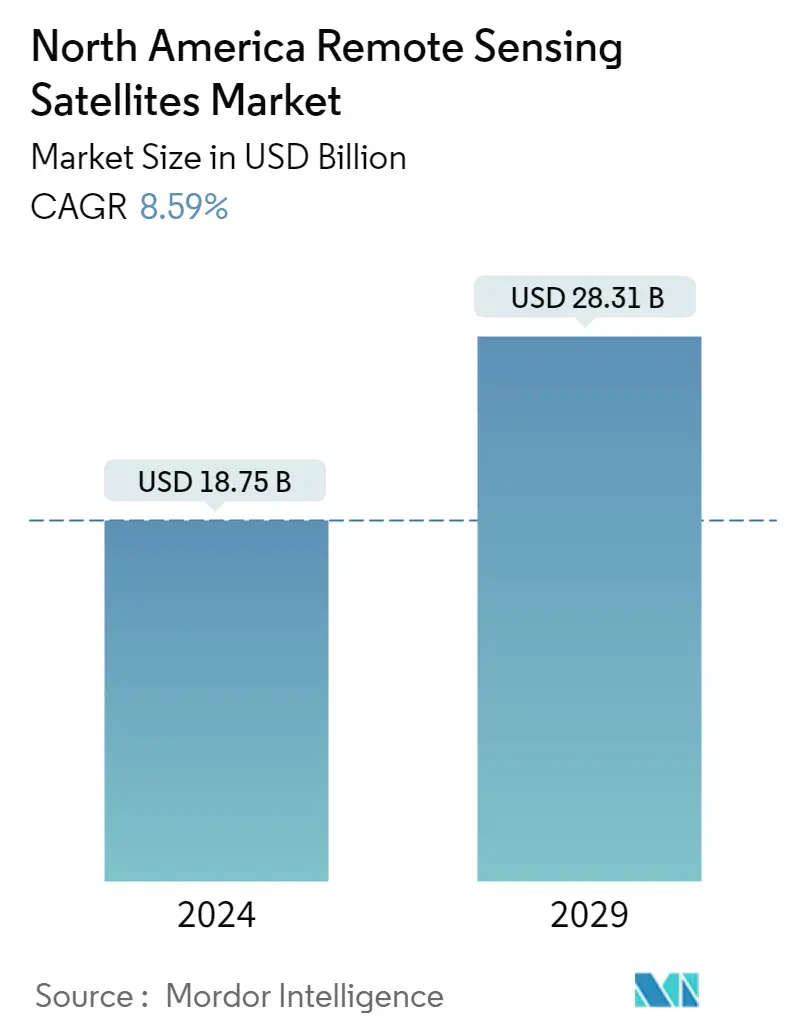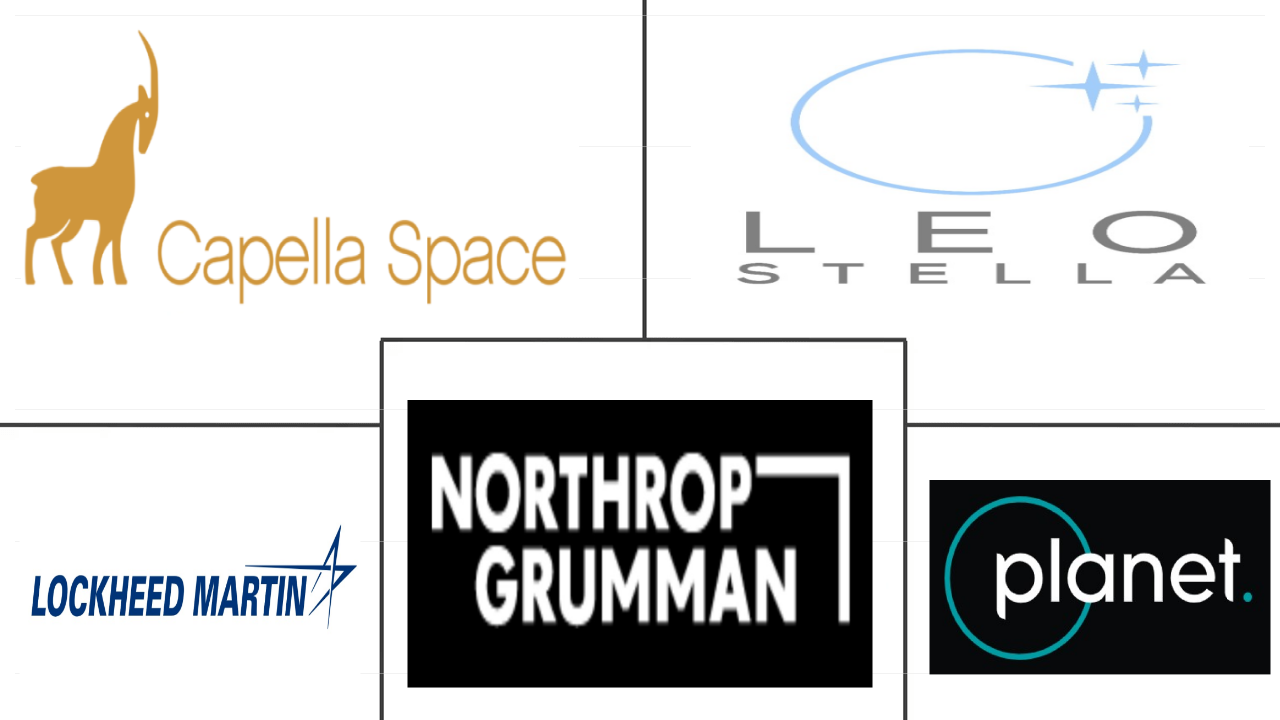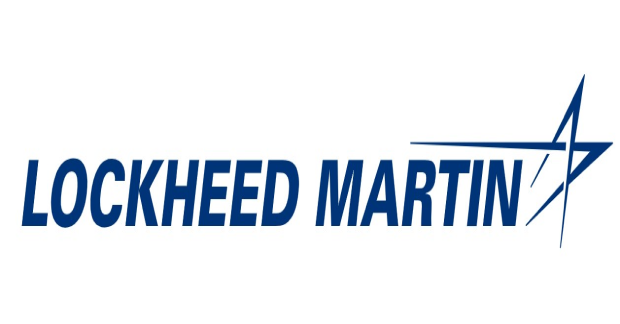Market Size of north america remote sensing satellites Industry

|
|
Study Period | 2017 - 2029 |
|
|
Market Size (2024) | USD 18.75 Billion |
|
|
Market Size (2029) | USD 28.31 Billion |
|
|
Largest Share by Orbit Class | LEO |
|
|
CAGR (2024 - 2029) | 8.59 % |
|
|
Largest Share by Country | United States |
Major Players |
||

|
||
|
*Disclaimer: Major Players sorted in no particular order |
North America Remote Sensing Satellites Market Analysis
The North America Remote Sensing Satellites Market size is estimated at USD 18.75 billion in 2024, and is expected to reach USD 28.31 billion by 2029, growing at a CAGR of 8.59% during the forecast period (2024-2029).
18.75 Billion
Market Size in 2024 (USD)
28.31 Billion
Market Size in 2029 (USD)
6.85 %
CAGR (2017-2023)
8.59 %
CAGR (2024-2029)
Largest Market by Satellite Mass
76.63 %
value share, above 1000kg, 2022
Large satellites register higher demand due to applications such as satellite radio, communications, remote sensing, planetary security, and weather forecasting.
Largest Market by Satellite Subsystem
80.28 %
value share, Propulsion Hardware and Propellant, 2022
The demand for these propulsion systems is driven by the launch of mass satellite constellations into space. They are used for transferring the spacecraft into orbit.
Largest Market by Orbit Class
87.05 %
value share, LEO, 2022
LEO satellites are increasingly being adopted in modern communication technologies as they play an important role in Earth observation applications.
Largest Market by End User
92.71 %
value share, Military & Government, 2022
The military and government segment is expected to grow significantly due to the increasing use of satellites in surveillance missions and the rising involvement of government space agencies in satellite development programs.
Leading Market Player
90.97 %
market share, Lockheed Martin Corporation, 2022

Lockheed Martin is the leading player in the market, with a robust product portfolio of military satellites. The company's civil and military customers include the USAF, US Navy, DARPA, NASA, and NOAA, which have helped it capture the highest share in the region.
The demand for LEO satellites is driving the segment's growth
- At launch, a satellite or spacecraft is usually placed into one of many special orbits around Earth, or it can be launched into an interplanetary journey. Satellites orbit the Earth at varying distances depending on their design and primary purpose. Each orbit has its own benefits and challenges, including increased coverage and decreased energy efficiency. Satellites in medium Earth orbit include navigational and specialized satellites designed to monitor a specific area. Most science satellites, including NASA's Earth Observing System, are in low Earth orbit.
- The different satellites manufactured and launched in this region have various applications. For instance, during 2017-2022, out of the seven satellites launched in MEO, most were built for navigation/global positioning purposes. Similarly, among the 32 satellites launched into GEO, most were deployed for communication and Earth observation purposes. Around 3000+ LEO satellites manufactured and launched were owned by North American organizations.
- The growing use of remote sensing satellites in areas such as electronic intelligence, Earth science/meteorology, laser imaging, optical imaging, and meteorology is expected to drive market demand during the forecast period. The market is expected to surge by 68% during the forecast period.
North America Remote Sensing Satellites Industry Segmentation
10-100kg, 100-500kg, 500-1000kg, Below 10 Kg, above 1000kg are covered as segments by Satellite Mass. GEO, LEO, MEO are covered as segments by Orbit Class. Propulsion Hardware and Propellant, Satellite Bus & Subsystems, Solar Array & Power Hardware, Structures, Harness & Mechanisms are covered as segments by Satellite Subsystem. Commercial, Military & Government are covered as segments by End User.
- At launch, a satellite or spacecraft is usually placed into one of many special orbits around Earth, or it can be launched into an interplanetary journey. Satellites orbit the Earth at varying distances depending on their design and primary purpose. Each orbit has its own benefits and challenges, including increased coverage and decreased energy efficiency. Satellites in medium Earth orbit include navigational and specialized satellites designed to monitor a specific area. Most science satellites, including NASA's Earth Observing System, are in low Earth orbit.
- The different satellites manufactured and launched in this region have various applications. For instance, during 2017-2022, out of the seven satellites launched in MEO, most were built for navigation/global positioning purposes. Similarly, among the 32 satellites launched into GEO, most were deployed for communication and Earth observation purposes. Around 3000+ LEO satellites manufactured and launched were owned by North American organizations.
- The growing use of remote sensing satellites in areas such as electronic intelligence, Earth science/meteorology, laser imaging, optical imaging, and meteorology is expected to drive market demand during the forecast period. The market is expected to surge by 68% during the forecast period.
| Satellite Mass | |
| 10-100kg | |
| 100-500kg | |
| 500-1000kg | |
| Below 10 Kg | |
| above 1000kg |
| Orbit Class | |
| GEO | |
| LEO | |
| MEO |
| Satellite Subsystem | |
| Propulsion Hardware and Propellant | |
| Satellite Bus & Subsystems | |
| Solar Array & Power Hardware | |
| Structures, Harness & Mechanisms |
| End User | |
| Commercial | |
| Military & Government | |
| Other |
North America Remote Sensing Satellites Market Size Summary
The North America Remote Sensing Satellites Market is poised for significant growth, driven by the increasing demand for advanced satellite technologies and applications. This market encompasses a diverse range of satellite types, including those in low Earth orbit (LEO), medium Earth orbit (MEO), and geostationary orbit (GEO), each serving distinct purposes such as navigation, communication, and Earth observation. The region's market is characterized by a robust presence of small satellites, which offer cost-effective alternatives to traditional satellites, making them highly attractive for scientific research, military, and defense applications. The United States, in particular, leads in the manufacture of small satellites, supported by substantial government investments and initiatives like NASA's CubeSat Launch initiative, which facilitates access to space for educational and research purposes.
The market landscape is fairly consolidated, with major players such as Capella Space Corp., LeoStella, Lockheed Martin Corporation, Northrop Grumman Corporation, and Planet Labs Inc. dominating the sector. These companies are actively involved in launching and operating satellites that cater to various needs, including high-resolution Earth observation and broadband connectivity. The Canadian space sector also plays a significant role, with government initiatives aimed at enhancing satellite technology and connectivity, particularly in rural areas. The region's commitment to space innovation is further underscored by substantial government expenditure and private sector investments, positioning North America as a key player in the global remote sensing satellites market.
North America Remote Sensing Satellites Market Size - Table of Contents
-
1. MARKET SEGMENTATION (includes market size in Value in USD, Forecasts up to 2029 and analysis of growth prospects)
-
1.1 Satellite Mass
-
1.1.1 10-100kg
-
1.1.2 100-500kg
-
1.1.3 500-1000kg
-
1.1.4 Below 10 Kg
-
1.1.5 above 1000kg
-
-
1.2 Orbit Class
-
1.2.1 GEO
-
1.2.2 LEO
-
1.2.3 MEO
-
-
1.3 Satellite Subsystem
-
1.3.1 Propulsion Hardware and Propellant
-
1.3.2 Satellite Bus & Subsystems
-
1.3.3 Solar Array & Power Hardware
-
1.3.4 Structures, Harness & Mechanisms
-
-
1.4 End User
-
1.4.1 Commercial
-
1.4.2 Military & Government
-
1.4.3 Other
-
-
North America Remote Sensing Satellites Market Size FAQs
How big is the North America Remote Sensing Satellites Market?
The North America Remote Sensing Satellites Market size is expected to reach USD 18.75 billion in 2024 and grow at a CAGR of 8.59% to reach USD 28.31 billion by 2029.
What is the current North America Remote Sensing Satellites Market size?
In 2024, the North America Remote Sensing Satellites Market size is expected to reach USD 18.75 billion.

